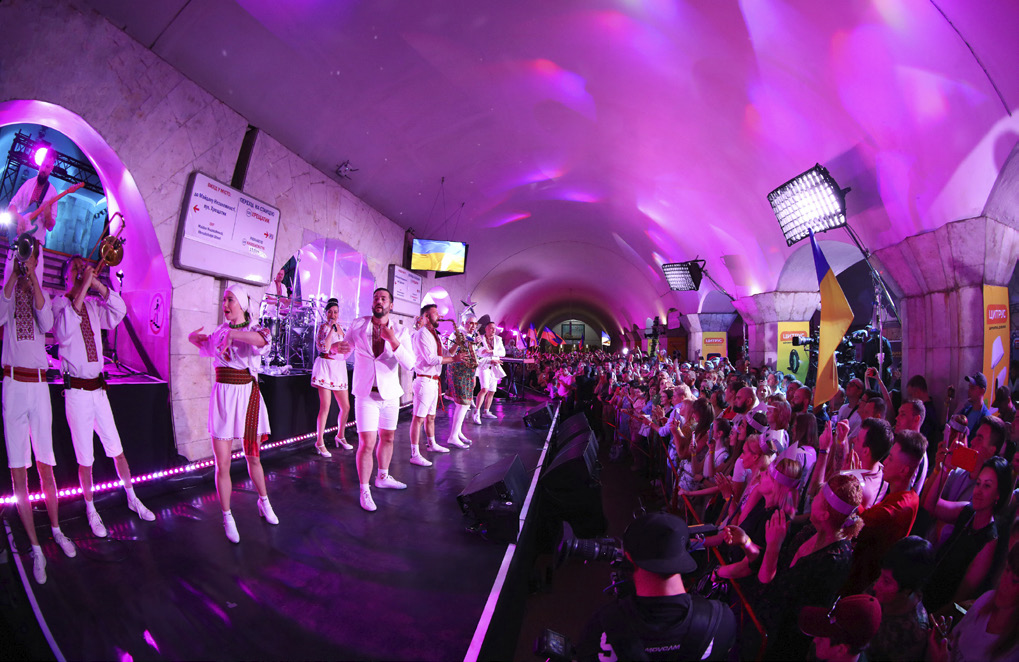The entertainment industry has weathered substantial challenges since the pandemic blew up in 2020. You likely remember the chaos, uncertainty, the feeling of loss…
Now, imagine being part of a community that weathered that storm only to find their world literally exploding around them. That’s the reality in Ukraine. And yet, live concerts by Ukrainian artists are still being mounted in the country and elsewhere in Europe. All are supported by Ukraine’s production industry; companies and individuals who – like so many of Ukraine’s population – are contributing to the nation’s defense, raising morale and funds using their skills in a situation that beggars description.
Much of that effort is centered on providing aid – money to purchase specific items for the army to weather the winter and assist in the war effort – everything from hot pockets and gloves to drones, ammunition, medicine, generators, Starlinks, and other supplies.
It’s important to keep a few facts in mind before we look at that effort and the work of those in Ukraine’s pro audio, production, and entertainment industry supporting it. The history of Ukraine and Russia are entwined; it’s a complicated relationship. After the USSR (Soviet Union) was dissolved, Ukraine gained independence, transitioned to a market economy, and was globally recognized as a sovereign nation.
Regardless of the causes and responses to the war, there can be no argument that the stakes are incredibly high, both for Ukraine and internationally. As for what the endgame will look like globally, well, you’d need a historian, a futurist, and maybe a crystal ball to make an educated guess. None of those, however, are necessary to see that Ukraine’s freedom as an independent state is under threat. Or that, even though the butcher’s bill is growing daily, the struggle to maintain that freedom – one most people thought would be brief and hopeless – shows no signs of ending, which speaks to Ukrainian determination to resist.

Hardest Times
That determination is mirrored in the day-to-day, night-to-night work of those who form the country’s entertainment industry community, who have found opportunities to serve in their own way. To get a sense of what that looks like, I spoke to two audio professionals from Ukraine who forwarded me information from the local pro community, enough for a series of articles in which we’ll cover a fair bit of ground – from the logistics and dangers of carrying on despite the danger to some innovative uses they’ve found for some technologies during the conflict to help mitigate that threat and defend themselves.
Their aim in sharing stories of the work of their peers in the entertainment industry and production community is simple, Volodymyr and Pavlo explained when we first spoke in October. “Being a part of the local pro audio community, we experienced and faced a lot of bad things; burned rental warehouses, a rocket attack on a venue with a technical crew on stage,” Volodymyr says. “But we want to make this story about the great spirit of our people, who continue to do their jobs through the hardest times.”
It’s worth noting how we connected with Volodymyr and Pavlo. They work with RealMusic, a local distribution company, and, being an L-Acoustics partner, their authorized rental/install partner in Ukraine, unsurprisingly, they’ve had close contacts with L-Acoustics for many years. While these pieces aren’t specifically about any one manufacturer’s products, our introduction came from Mary Beth Henson, who leads L-Acoustics worldwide media relations.
Given the context, Henson was surprised to hear that they’re still working: “I found the exchange with them to be heartening and very interesting. It made me think that their stories would be of interest to their pro audio peers.”
Volodymyr, Pavlo and Henson discussed a recent installation project at Emily Event Hall in Lviv, which was completed just before the invasion. “RealMusic is one of the leading audio and MI distribution companies in Ukraine, and Emily Hall is a direct project of our installation team, so Pavlo and I were deeply involved,” Volodymyr explains.
Then, with Emily Hall in mind, he gives an account of where he and Pavlo were at the start of the conflict. “We do demos called Open Days. In this case, we had an open day with L-Acoustics’ latest full-range line array, the K3 (at Emily Hall). It was installed and our Open Day was planned for February 24. We arrived at the venue the day before and had everything ready; people invited, catering booked, and everything set up and checked. But the next morning, we woke up in a new reality.”

Volodymyr goes on to explain they headed back to Kyiv that day to be with their families – “But it’s another story,” he adds with a shrug.
Since then, Emily Event Hall has been used as the site of various charity events to aid Ukraine’s people and military. Live music is, in fact, very much alive in Ukraine – although the gigs are being organized and presented in the face of tremendous challenges and in some unusual venues.
Among them, shows for broadcast and for live audiences mounted in metro stations, which, as you can imagine, are safer than shows above ground but still present unique challenges. Additionally, Ukrainian artists are touring outside the country, giving others a direct means of providing donations for Ukraine. “This is how, this is where we participate,” Volodymyr says bluntly.
Myriad Concerns
Earlier, during our first call, Pavlo was the first to join the chat. While we wait for Volodymyr, he tells me he’s just returned to Kyiv after being on tour elsewhere in Europe doing charity shows with the Ukrainian Eurovision star, Verka Serduchka. During that time, he obviously had concerns about his family and friends.
“My girlfriend was at home, and I was away. But before, the situation was the opposite,” Pavlo says. “She was working in Italy and I was in Kyiv when there were attacks near the city center, but she was much more scared than me. I said, ‘Relax. Everything is OK in our home.’ But then, I was on the opposite side, touring in Poland – it’s even scarier to be in a safe place when your girlfriend and family are in Kyiv in the city center. You’re trying to read the news…” Pavlo pauses. “But now I’m back, so it feels better.”

Almost immediately after that, Volodymyr joins us. “Sorry for my late appearance,” he says, “but we have problems with electricity now, so I switched to a generator as a workaround. I’m near Kyiv, in Bucha, in my house.”
It’s striking to me to hear him say this so casually. Meeting face to face, if only virtually, with people living through the destruction and carnage the news that I’m consuming daily describes is… Well, it’s hard to put into words. And any words I try to put my thoughts and concerns into seem, frankly, inadequate at best.
My first thought, naturally, is that Bucha, in the weeks preceding our conversation, has been a focus of coverage, specifically of the occupation, investigations into Russian war crimes, and, ultimately, the town’s liberation.
Anticipating my next question, Volodymyr tells me he wasn’t in Bucha during the occupation. “I was fortunate that my wife persuaded me to leave in the first days (of the war). We moved to west Ukraine for a while. For those left here, it was really tough, many people, many acquaintances, just didn’t survive, but it’s another story.”
He thanks me for the interest we’re taking in their stories, stories they’re intent on sharing, something they hadn’t planned on doing, but when Henson suggested it, decided to do so as a means of describing “what Ukraine’s show business looks like today after eight months of Russia’s invasion,” adding, “Yesterday was eight months exactly.
“It’s tough, as you might understand,” Volodymyr continues. “Basically, it’s not safe to make concerts in typical venues like clubs or concert halls. So, many concerts are held in metro stations or shelters where it’s safe. It’s not all about entertainment, but about charity needs and the support of the army.”
Next, sharing his screen, Volodymyr takes me through a series of photos they’ve compiled, first of the metro concerts, then of the freshly completed Emily Hall project from early February. There’s a lot to cover and many images to share; some look no different from what you’d see in the average install profile or commercial case study, and some are far outside the norm for trade magazines.
Where It’s Going
We’ll be covering these stories in a special series of pieces, which – in line with Volodymyr and Pavlo’s wishes – will present the reality as they’ve experienced it. But the focus, Volodymyr emphasizes, should not be about suffering but resiliency, and on Ukraine’s production and entertainment industry doing what it can to help and the logistics of doing so – via charity initiatives to raise morale and awareness at home and elsewhere, by sharing rental gear with others whose storage facilities and offices have been damaged by shelling, and by repurposing entertainment technology for direct usage by Ukraine’s defenders.

“The shows taking place in the metro stations, in Kyiv and elsewhere,” says Pavlo, as they share more photos with me, “they were not open to the public. They were a way to say thank you to all the volunteers, the teachers, the medical teams, and the Ukrainian Army – to say thank you to all the people doing their job and doing it well.” Others, however, he adds, sharing shots of similar performances were public concerts.
“The gear may look tiny but it is a metro station,” Volodymyr notes. Beyond shows in Ukraine, he also shares images from charity tours featuring Ukrainian bands in Europe. “It’s important to mention that artists want to support the country and army the way they can, professionally,” he adds.
Also important is the use of production technology to “support fighters and save lives,” something he says he’ll look into further, adding that he knows someone who worked on the metro shows who may be willing to speak about that in more detail.
“He’s busy,” Pavlo adds, “not only doing this type of work but working on air defense systems to locate and find drones.” In short, they’ll send more information and photos after reaching out to their colleagues for comments and sharing that information as they gather it.
Another point, Volodymyr notes, picking up his former train of thought, is telegraphing hope for the future, which Emily Hall is tied into. “When the project began, none of this was our main concern. But this one (Emily Hall) could be a symbol of hope for a venue like this to open, doing charity concerts.
“The point is that you cannot stop life,” he sums up. “This is the main idea. We believe in our victory, and we know it will be ours. Unfortunately, there are a lot of victims, and will be more. But we know, for sure, we are on the right side in this war and we are absolutely right in what we do. The songs, the concerts, it’s about victory and hope.”















